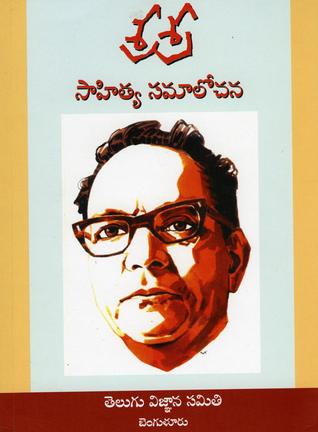 Sri Sri Sahitya Samalochana, Edited by Dr. Diwakarla Rajeswari, Ambika Ananth.
Sri Sri Sahitya Samalochana, Edited by Dr. Diwakarla Rajeswari, Ambika Ananth.
Like other Indian languages, Telugu too has been imbibing, from time to time, various trends and ideologies emanating from across the world, particularly in relation to European countries.
Dissemination of English language during the British rule facilitated easy access in this. A section of young poets looked for new modes to give vent to their poetic spirit in the altered context.
In the post-war period Impressionism, Dadaism, Imagism, Cubism, Symbolism, Futurism, Realism, Surrealism and the like fascinated them. Developments in Russia and the International Labour Movement expounding the cause of working class operated as a source of major inspiration for them . Further, Marxist philosophy attracted them . They started writing poetry with a new outlook called Progressivism, relegating Romanticism to the background.
Srirangam Srinivasa Rao, popularly known as Sri Sri, was the pioneer in this direction and was acclaimed as an epoch maker. Sri Sri- Sahitya Samalochana is a compilation of 20 research papers presented by noted scholars, at the National Seminar conducted under the joint auspices of Telugu Vignana Samithi, Bangalore and Central Sahitya Akademi, New Delhi in December 2009, to mark Sri Sri’s birth centenary.
Four more articles are included in a booklet as an appendage. As the title indicates, the writers deliberate on the works of Sri Sri with much diligence and comprehension. Addepalli Ramamohana Rao gives an enlightening analysis of Sri Sri’s Magnum Opus ‘Mahaprasthanam, with particular reference to the element of reality perceived from different angles. S.V. Satyanarayana aptly calls the work a progressive epic, which, he says, is a poetic interpretation of Marxism.
In his article on ‘Prabhava’, Kasala Nagabhushanam traces in detail Sri Sri’s transformation into a progressive poet, with ample quotations. Dwa.Na.Sastry, while assessing Sri Sri’s ‘Siprali’ dwells on the humorous ingredient of the poems and attributes of his parodies.
Unique features of Sri Sri’s radio plays are well presented by C.Mrinalini. Ambika Ananth in her appraisal of ‘Three Cheers for Man’ cites, inter alia, Sri Sri’s English translation of some of his own poems and makes a prudent suggestion that a translation workshop may be organised for translating his works. Kopparthi Venkataramana Murty observes that ‘Anantham’ though penned as a sort of novel, embedding autobiography, reflects the ‘soul’ of history of his period. Diwakarla Rajeswari states that Sri Sri’s essays are in a way innovative writings exploiting prose to the optimum extent. Sri Sri’s original and translated stories demonstrate his command over the genre, contends Ampasayya Naveen. ‘Khadga Srushti’ is replete with thematic diversity keeping the common man at the centre stage.
Yet another aspect of Sri Sri’s writing — his film lyrics — are surveyed by Rasaraju, who avers that every piece carries his stamp. G. S. Mohan writing on Sri Sri’s prefaces and reviews reveals that they are quite spirited, thoughtful and analytical.
In her paper on Sri Sri’s letters, K. Asajyothi proves how they are embellished with discussions on literature. Channapragada Jayalakshmi feels that Sri Sri’s ‘Pra-Ja’ (Questions and Answers) amply bears out his inscrutable nature. Markudapuram Srinivasa shares his experiences during the course of his Kannada translation of ‘Maha Prasthanam’. The other articles are equally educative. Inclusion of selectpoems of Sri Sri to the book is a welcome addition.
By all counts, this is a work of immense interest to innumerable admirers of Sri Sri. The publishers should have paid greater attention to its format, as it highly deserves a proper structure of a well bound treatise, rather than an adhoc souvenir that it seems now. A chronogical list of Sri Sri’s work would also be a useful annexureif and when the book goes into a reprint.
Sri Sri Sahitya Samalochana
Edited by Dr. Diwakarla Rajeswari, Ambika Ananth.
For copies: Visalandhra Book House
Price: Rs.200.
source: http://www.TheHindu.com / Home> Arts> Books / by Govindaraju RamaKrishna Rao / May 31st, 2012